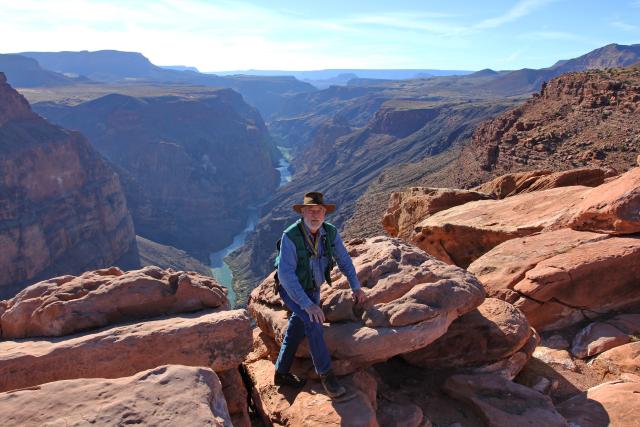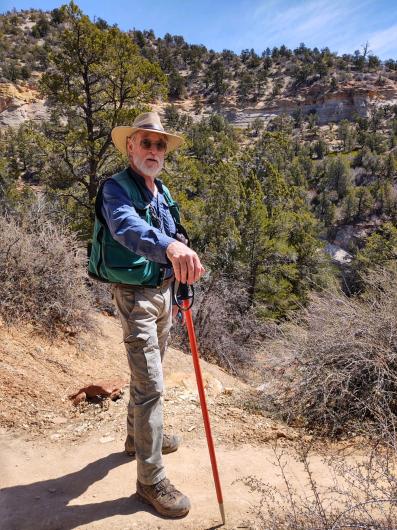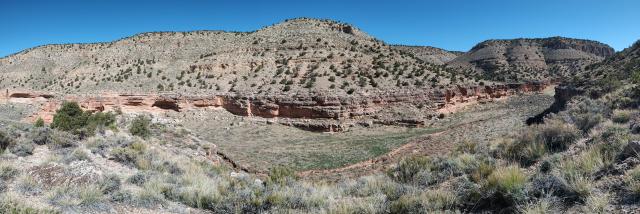You are viewing ARCHIVED content published online before January 20, 2025. Please note that this content is NOT UPDATED, and links may not work. Additionally, any previously issued diversity, equity, inclusion or gender-related guidance on this webpage should be considered rescinded. For current information, visit https://www.blm.gov/blog.
Retired forester Doug Page returns to public lands as a BLM site steward volunteer

Douglas H. Page, Jr. is a retired forester currently volunteering as regional coordinator with the Arizona Site Steward Program, or ASSP.
As a forester, Doug spent the latter part of his career in the West, with his final position as Southwest Utah Zone forester based out of the Bureau of Land Management Cedar City District Office. Prior to that position, Doug has worked on the Uinta National Forest, Targhee National Forest, Coconino National Forest, Utah Division of State Lands and Forestry, Texas Forest Service, Wasatch National Forest, Wallowa Whitman National Forest, among several others.
Like many public servants, Doug’s passion for giving back did not stop after retirement.
“I have been volunteering for BLM, U.S. Forest Service, and some for various universities since I retired in 2014, in part to remain active and involved and in part to finish up some research related projects,” Doug said. “I was a BLM archaeological volunteer for the Arizona Strip for two years prior to becoming a volunteer with the Site Steward Program.”
In 2019, Doug became an Arizona Site Steward volunteer for the Bureau of Land Management where assists land management agencies in preserving cultural and historical heritage sites. The Arizona Site Stewards Program (ASSP) is a statewide organization managed by the Arizona State Historic Preservation Office, which recruits, trains, and places volunteers with federal, state, tribal, and local land management agencies to monitor cultural and historic heritage sites and report any changes or disturbances such as looting or vandalism. For the past 37 years, the Arizona Site Steward program has served as a critical part in the protection and preservation of cultural resources.
After serving as a volunteer for several years, Doug took over as regional coordinator of the Arizona Site Steward Program after the previous regional coordinator stepped down in 2020.
“The regional coordinator has more opportunities to get involved in so much more than a site steward, including survey for and recording sites, evaluation of new sites that may warrant addition to the Program, training new stewards, and a fuller knowledge of sites that are not just those in the Program,” Doug said. It has given me a broader understanding of the archaeology of the Arizona Strip that I would likely have ever obtained as a steward.
Since becoming regional coordinator, Doug has collaborated closely with the archaeologists from the Arizona Strip Field Office (ASFO) and the North Kaibab Ranger District of the Kaibab National Forest to oversee and train volunteers in monitoring archaeological sites on the BLM and the U.S. Forest Service.
Doug and the BLM Arizona Strip Field Office archeologist, Sarah, are an unlikely pair: They are father and daughter.
“Beyond Doug being my father, it's fun to get out in the field with him and with other Site Stewards to show them archaeological sites, have them help with conducting cultural resource inventories, and help record archaeological sites,” said Sarah Page, BLM Arizona Strip Field Office archeologist. “I credit my parents with introducing me to archaeology and my dad in getting my first volunteer experience with the forest archaeologist he worked with while at the Uinta National Forest. He has been very supportive of my career, and I know he enjoys visiting archaeological sites on the Arizona Strip for both the BLM and the Kaibab National Forest.”

At the heart of every volunteer is stewardship
Many ASSP volunteers, like Doug, are drawn to the history of a region, have an interest in archaeology (or are retired archaeologists or para-archaeologists), love getting outdoors, or have ancestral ties to an area.
“It’s a great way to stay active, remain engaged, and contribute to furthering knowledge of local resources,” Doug said. “It is also a great way to meet some really interesting people who I never would have met otherwise.”
Once learning about the ASSP and its mission, site steward volunteers dedicate their knowledge, energy, and time to monitor vulnerable archaeological sites, because they care about protecting the sites and cultural resources. They understand its importance to the field of archaeology and, most importantly, the importance to descendant communities, such as Native American Tribes or local families whose ancestors arrived in an area to make a permanent home.
“I find it so fun to learn about the backgrounds of the Site Steward volunteers and why they decided to become a volunteer. We have a couple of retired archaeologists, a gentleman from England, a woman who volunteered with the BLM Wild Horse and Burro Program, as well as so many others,” Sarah said.
“I also really enjoy taking them to the field and showing them around an archaeological site and talking about the history of the region. They get so excited to learn just how long Native Americans, Europeans, and Americans have lived in the region,” Sarah said. “Any time I can talk about archaeology to people interested in learning, I take the opportunity.”

BLM Arizona acknowledges Arizona Site Steward Program partnership
The BLM and its archaeologists are huge supporters of the ASSP. The BLM manages 12.1 million acres of Arizona’s public lands. On BLM-managed public lands in Arizona, there are two National Historic Landmarks as well as 21 places listed on the National Register of Historic Places.
In particular, the Arizona Strip has some of the most unique archaeological sites in the state. In working with ASSP volunteers, BLM archaeologists quickly observe and document damage to an archaeological site, which provides land managers with valuable information to assess a site’s condition and, if necessary, implement additional measures for protecting a site against inadvertent and deliberate vandalism. BLM Arizona Law Enforcement also contributes to documenting and investigating resource damage, who historically visit two cultural or paleontological resources per day on average statewide.
The ASFO archaeologist includes volunteer help in other projects, including ongoing annual cultural surveys on Vermilion Cliffs National Monument. This opportunity allows site stewards to learn more about how archaeologists conduct fieldwork, but also how they document archaeological sites. Plus, site steward volunteers are always amazed at the breadth of archaeological sites on the ASFO.
“Memories are made daily especially when field work is involved,” Doug said. “Some of the most memorable times have been when we get together as a group of stewards with professional archaeologists and spend several days in the field doing survey work in areas not previously or completely surveyed in the past. That is where we find ‘new’ sites that may raise new questions or in some cases help to answer old questions.”
“As the Arizona Strip archaeologist, I could not manage without his and the other volunteers’ help and dedication to the resource. It has been a great partnership and hopefully it will continue far into the future,” Sarah said.
Doug has also helped improve the BLM Arizona Site Steward program across the state.
"One of the many things I appreciate about Doug is his ability to problem solve and bring fresh ideas to the table,” said Brooke Wheeler, the BLM Arizona State volunteer lead. Brooke communicates overall volunteer management policy guidance, process changes, and training opportunities to the BLM staff and statewide partners like the ASSP regional coordinators and appreciate Doug’s perspective to improve the program.
“Whether it is how to improve a process or a form, Doug never hesitates to bring these things to my awareness. His dedication to the Site Steward program deserves to be acknowledge and praised,”Brooke said.
Doug has taken part in every Vermilion Cliffs National Monument project since 2018. Doug has been invaluable in bringing in new volunteers, in training volunteers on how best to monitor an archaeological site, and in supporting the Arizona Strip archaeologist in identifying damage to sites.
“If you are even just curious about the local archaeology and feel there is more you would like to learn and understand, then JUST DO IT,” Doug said.
Want to volunteer with BLM Arizona? Learn how.
Sarah Page, Arizona Strip Field Office Archeologist
Related Stories
- Remembering the cattle drive that defined ranching in southeastern Arizona
- Smokey Bear joins Mr. & Mrs. Claus to continue LTVA annual toy giveaway
- BLM Fire Team brings Smokey Bear to Kingman’s Street of Lights
- Rural wildland firefighting partners grateful for BLM gift
- BLM hosts fire investigation training course to strengthen wildland fire investigation capacity across Arizona and the West
Office
4001 East Aviator Drive
St. George, UT 84790
United States
